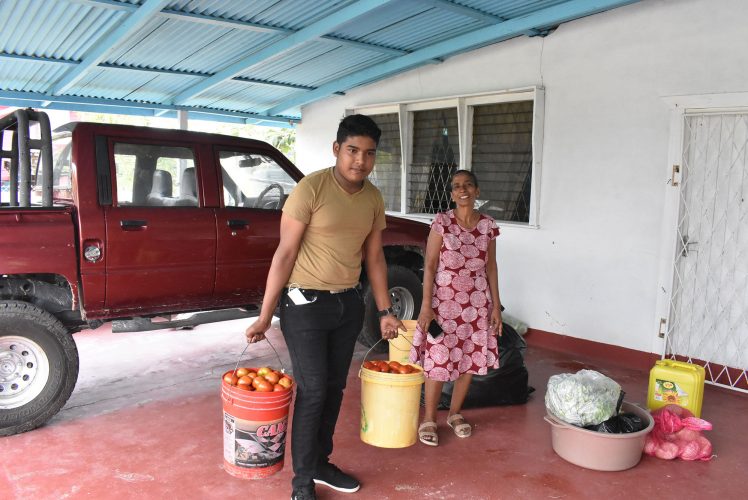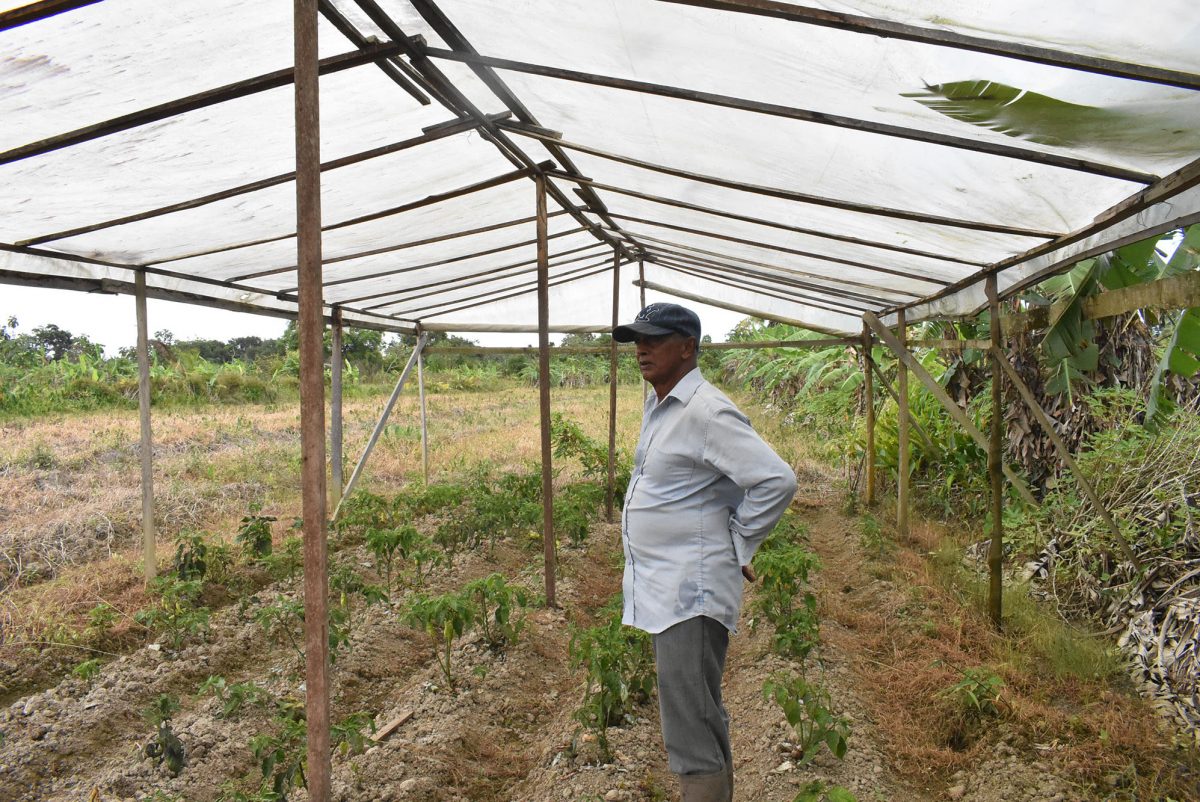What is known as Parika Back is an expansive area situated roughly two and a half miles from the Parika Public Road. Its appearance suggests that it has existed in the present state from time immemorial. It appears too, to have been divinely designated for farming.
The entire area is divided into four communities: Ruby Back, Parika Back, Naamryck, and the Savannah Backlands. Collectively, the communities are well-known for their prolific cultivation of cash crops, primarily vegetables. Cattle and poultry-rearing are pursued here too.
No matter what your substantive pursuits are, if you live in Parika Back you are, in one way or another, hinged to farming. Teachers and other public servants who reside here… they too are ‘farmers’ even if their spreads may sometimes cover a meagre half an acre.

The Parika/Ruby/Nymaka Farmers’ Progressive Organization (PRNFPO) appears to exercise a fair measure of clout in Parika Back where farming is concerned. Kapil Rampersaud is PRNFPO’s Chairman. We met with him along with Deodatt Seodatt, the Organization’s Secretary and another member, Seoraj Persaud Seepersaud.
PRNFPO has around ninety members ‘on the books.’ Only a third of these are active members. Still, the organisation appears to see itself as lobbyists for the entire community. After all, it would make no sense in leaving two thirds of the farmers behind. The ‘bottom line,’ PRNFPO believes, is to ensure that the community’s farming pursuits provide a reasonable living for the families living there. Some cultivate on a farm-to-pot basis. Others are hard-nosed businessmen who must market their produce to make a living.
The PRNFPO officials say that the bustling farming community is battling on three fronts… financing what, all too frequently, are costly operations; erratic prices for produce, and drainage and irrigation woes. Rampersaud himself makes no secret of his hope that of the $22.6 billion allocated for agriculture in the 2021 budget, a sufficiently substantial amount will be assigned to growing small agricultural pursuits like those at Parika Back. “I did not hear anything about cash crop farmers. Agriculture is not rice and sugar alone… cash crop farmers feed the nation too and need assistance,” he declares.
Rampersaud recalls that some years earlier he had been part of a lobby for a Trade Union for cash crop farmers. His lobby had fallen mostly on deaf ears. He bemoans the fact that sugar and rice thrive on the facility of much more effective lobby groups. “Cash crop farmers have no support group to fight their corner,” he says.
PRNFPO was created about twenty years ago. Its formal registration came much later, in 2008. Rampersaud credits an organisation known as the Canadian Hunger Foundation (CHF), mandated to supporting poor rural communities in developing countries in pursuit of sustainable livelihoods with the advancement of the group. He also says that PRNFPO members have benefitted from training and other forms of assistance from IICA, PROPEL, and the FAO. He recalls that PROPEL had been instrumental in arranging for members of PRNFPO to visit Jamaica to observe shade house farming. Parika Back farmers, he said, had also benefitted from PROPEL-organised visits to communities across Guyana including Bath Settlement, Mocha, and Mahaicony, to observe farming practices in those communities.
Seodatt, the organization’s secretary, was one of the members of the group who made the PROPEL-sponsored visit to Jamaica. The experience, he says, has made him more aware of the role that changing weather patterns continue to play in food cultivation. Recently, he was provided with material for an 18ft x 24ft shade house by IICA. While he is keen on shade house farming, he is concerned that the costs associated with erecting shade houses are rapidly moving beyond the reach of low-budget farmers.
The creation of efficient shade houses, Seodatt says, requires the acquisition of a range of materials that include seed trays, water tanks, PVC pipes, sprinklers, pumps, plastic, wood and fertilizers. “Many farmers cannot afford those costs,” he says.
These days, Seodatt, a cabbage farmer, faces his own personal challenges. Over the past six months some of his time has had to be allocated to being a caregiver to his wife who has developed a tumour. Currently, he is confined mostly to cultivating Kale in his Shade House. Some local food outlets including Massy and Foodmax have expressed interest in serving as outlets for his Kale. Seodatt also cultivates parsley and broccoli.
When, finally, it is his turn to speak, Seepersaud is keen to articulate his frustrations regarding the relationship between small farmers and the banking system. He recalled several years ago, the day when, in the company of his father, he visited the GAIBANK in Kingston. There, without a great deal of fuss and fanfare he was granted a low-interest loan with no hassle. He points as well to what he says are the hassles associated with securing loans from other lending institutions. In one particular instance, he recalls, the processing fee associated with negotiating the loan amounted to around one third of the amount of the loan. There is no incentive for his children to become farmers, he says. If agriculture is to be encouraged, he says, there simply must be a lending institution established specifically to grant farmers generous loans at low interest rates. The prevailing interest rates of between 16% and 30% are simply too burdensome for farmers, he says.
In 2007, Seodatt discovered that he was allergic to non-organic fertilisers. He had little choice but to switch to organic fertilizers. These are more costly and the impact on his overall cost of production has been significant.
Rampersaud says that the Pesticides Board visited and held a workshop on fertilisers and pesticides. However, he wants follow up sessions to ensure that farmers adhere to rules and regulations on the application of pesticides and fertilisers. He is urging personnel to visit regularly to test the plants for fertilisers. The prices of organically produced greens and vegetables can impact significantly on competitiveness.
Seepersaud says that while farmers are keen on knowledge-enhancing training courses, these must be tied to their particular needs. They are fretful, he says, over what, frequently, is the arbitrariness with which courses are thrust upon them. He alluded to a recent case in which farmers from the Parika Back group were invited to participate in a training exercise associated with packaging and labelling. Upon turning up, he says, the farmers discovered that the workshop was intended specifically for agro-processors. The real priority, he says, is the restoration of the dilapidated roads used to convey produce to market.
Seepersaud believes that Parika Back is producing sufficient quantities of fruit and vegetables to warrant an adequate storage facility. There have, it seems, been misunderstandings with regard to the functions which the Guyana Marketing Corporation’s storage facility at Parika are intended to serve. While the misunderstandings have persisted and while dozen of canters, minibuses and cars remove produce from Parika Back farms, the farmers, Seepersaud says, would be altogether prepared to surrender a portion of land for the placement of a cold storage facility. He is, himself, contemplating investment in a modest cold storage facility for his own use, so tired he is, he says, of the volumes of waste that arise out of the absence of such a facility. He alluded to an existing instance in which his own daughter must choose between leaving almost 20,000 head of pak choi to rot in the ground or else, to reap these and sell them at between four and five dollars per head.
Seodatt says that transforming crops into monetary profit is no ‘walk in the park.’ There are too many potential loopholes, too many ways to fail. He says that there are times, many times, when farmers who struggle are inclined to give up. Two things keep them going. The absence of any realistic option and what, over time, has been their emotional attachment to the land. In many cases, entire lifetimes have been spent in a farming setting. There are days, Seodatt says, when the land favours you, when the crops are bountiful and when the prices are right… those are the times that farmers live for.
Most of the Parika Back farmers sell their crops to middlemen. Some of them make the trip to the Hydronie Market. Every day more than a dozen middlemen descend on the farms to purchase the produce. Some of it is marketed on the West Bank and West Coast. There are markets in Bartica, on the Essequibo Coast, and in Linden and Berbice. The bounty is sufficient for some to find its way to the markets in Georgetown.
Sometimes interesting situations can arise. Seepersaud says that three months ago when the price of pak choi has shot through the roof, production turned sharply in that direction. The attendant glut forced prices down and thousands of heads of one of Guyana’s choice vegetables were left to rot in the ground. Here, he believes, is the kind of ‘luck-of-the-draw circumstance that is a characteristic of the lives of the farmers of Parika Back. The current price of peppers, he says, is four hundred dollars a pound and currently there is a race to get pepper seeds into the ground.
Over time, however, many of the farmers have learnt from their mistakes. These days they are far more reluctant to follow prices.
Wherever rice and cash crops are farmed in contiguous or near contiguous areas, there occurs, frequently, clashes over water. Parika Back is no exception. In this instance the clashes occur, mostly, over the timing of the release of water. Seepersaud wants a schedule for the release of water for the cash crop farmers. Cash crops need water regularly, he says. They cannot wait for the rains. He believes that the twice weekly release of water to the farmers should suffice.
Many of the families in Parika Back are vehicle owners. That has to do with the distance from the community to the public road. Moving a single bag of pak choi from the farm to the public road can set you back two hundred dollars in transportation costs.
All three farmers say that despite the challenges they will continue to farm. That is what they know. Their roots are there. Whether they see their children holding fast to their farming ways, however, was not a question that they seemed that keen to answer.






